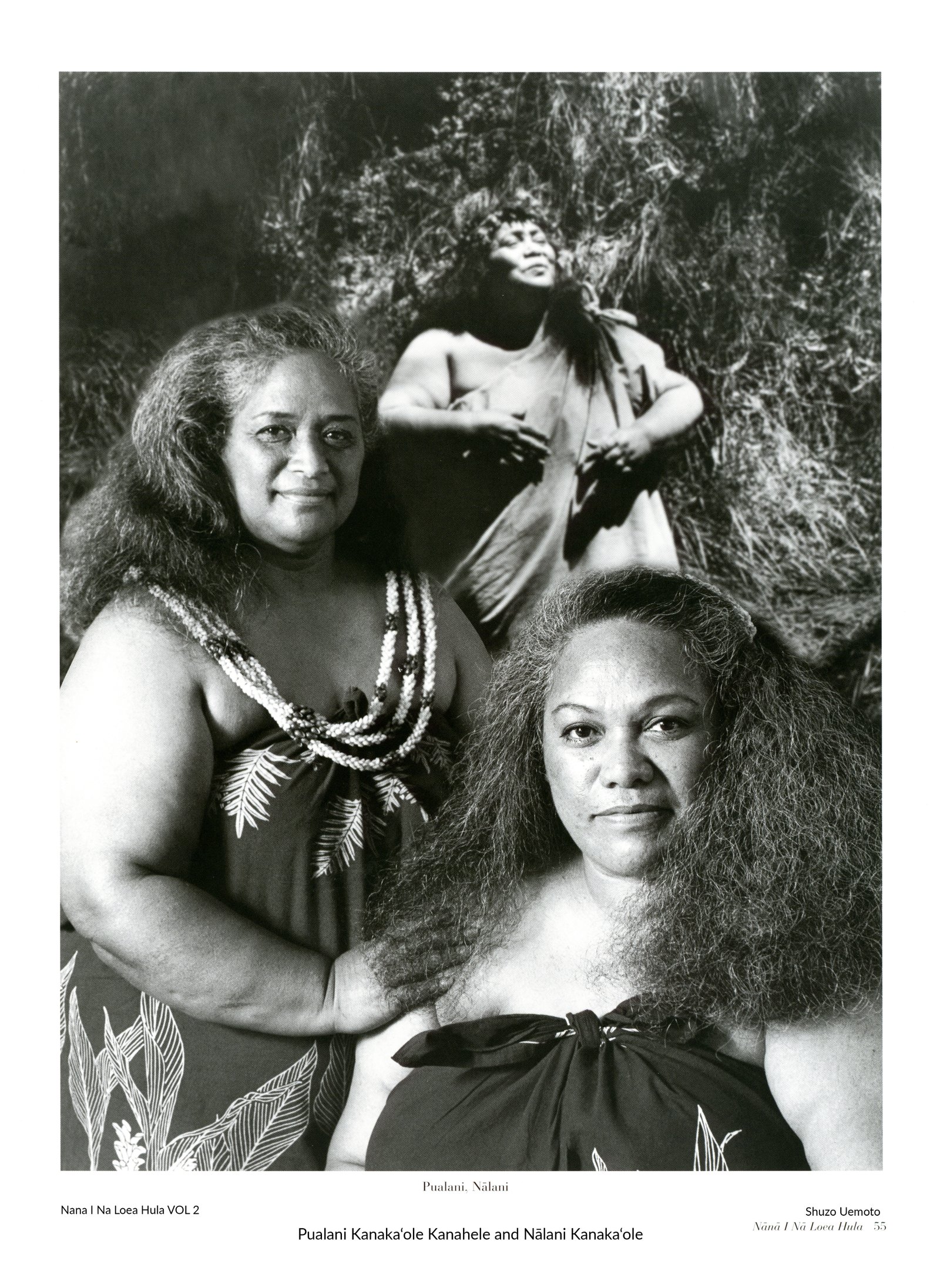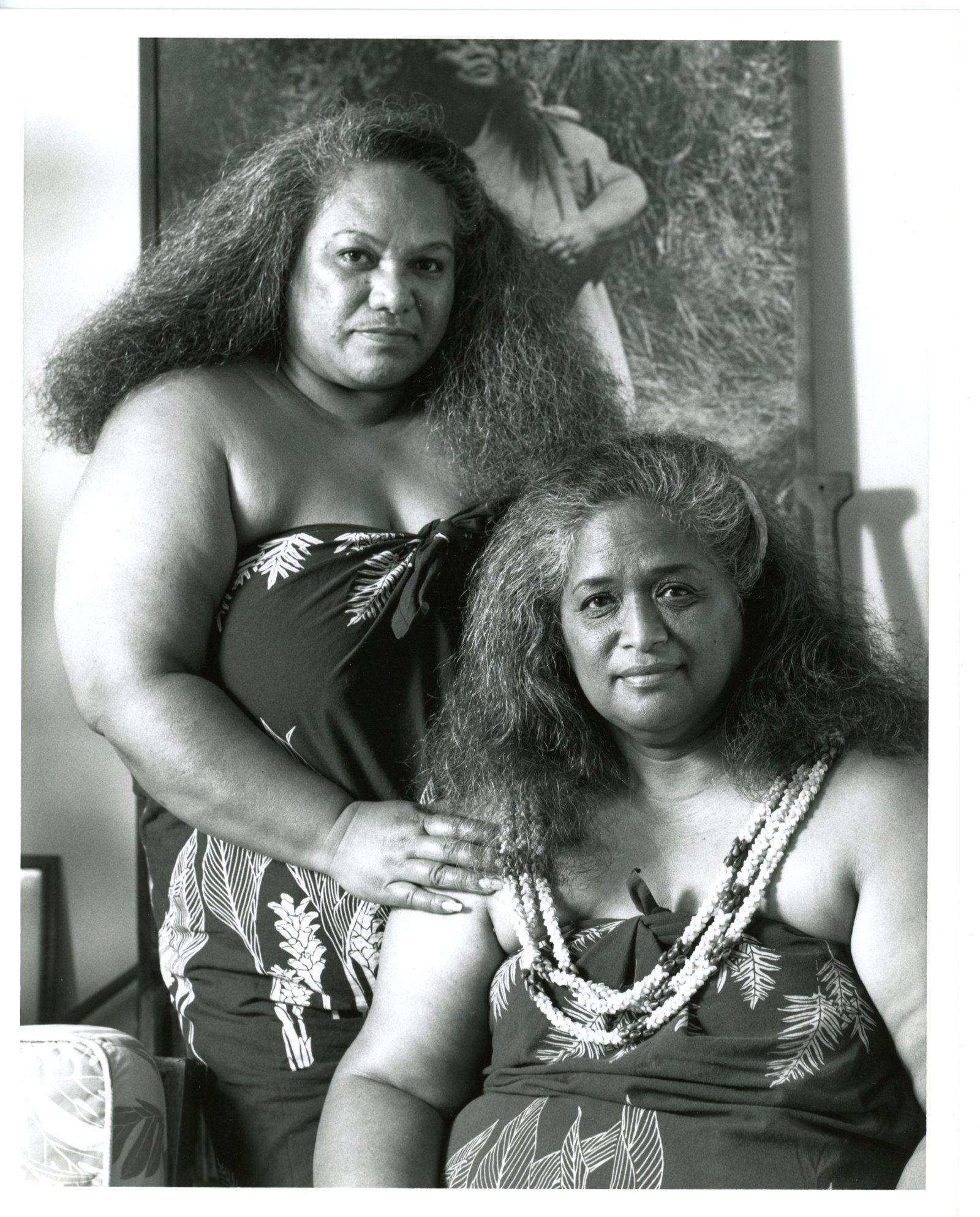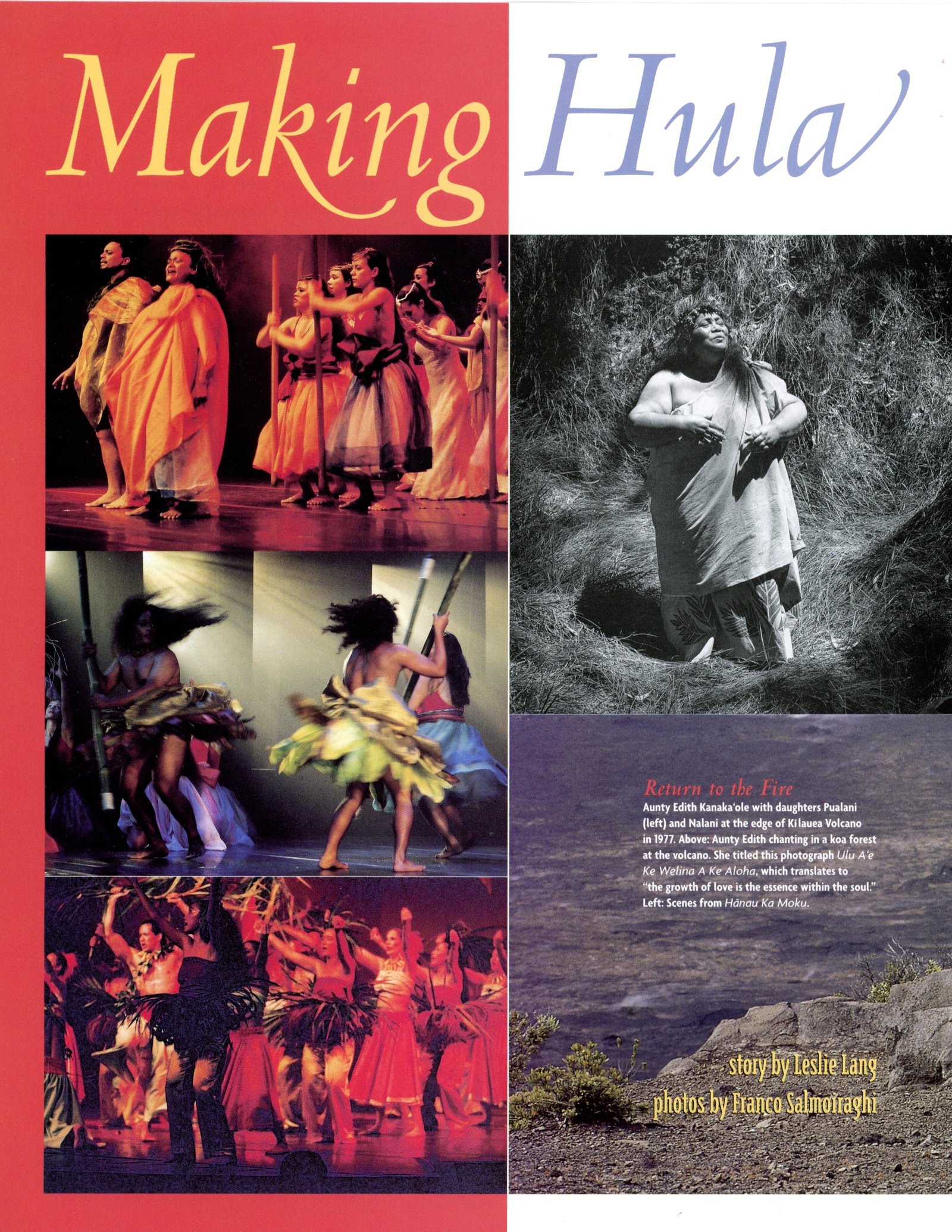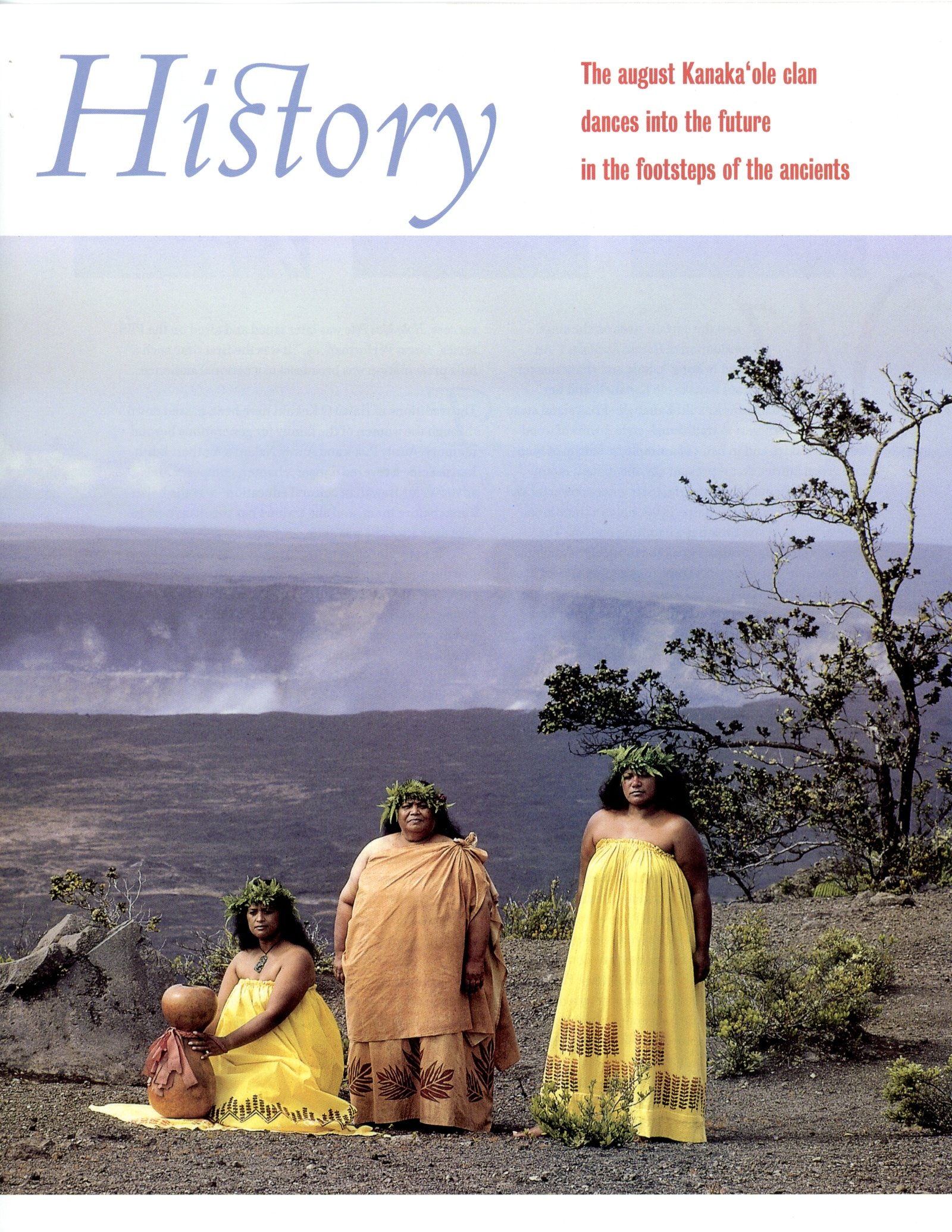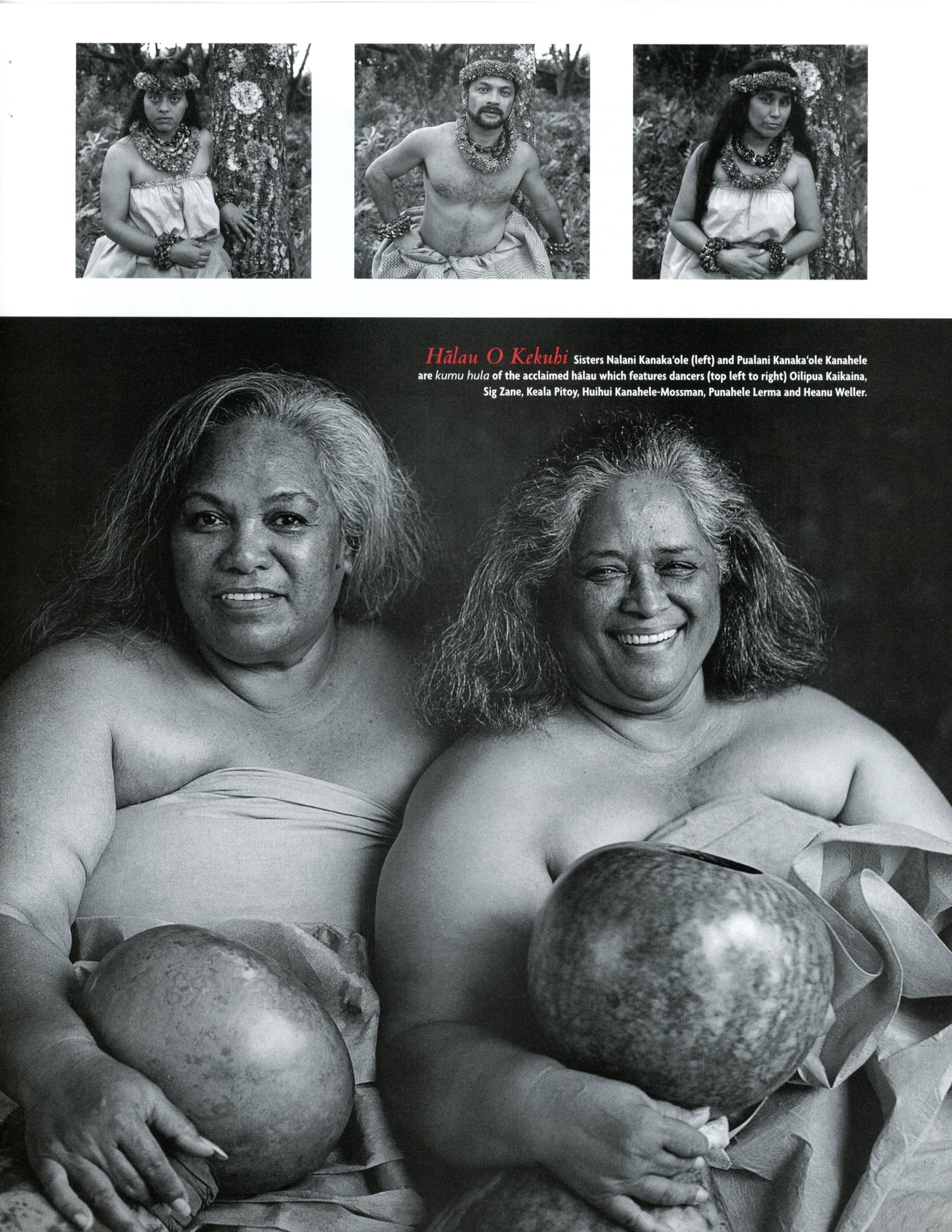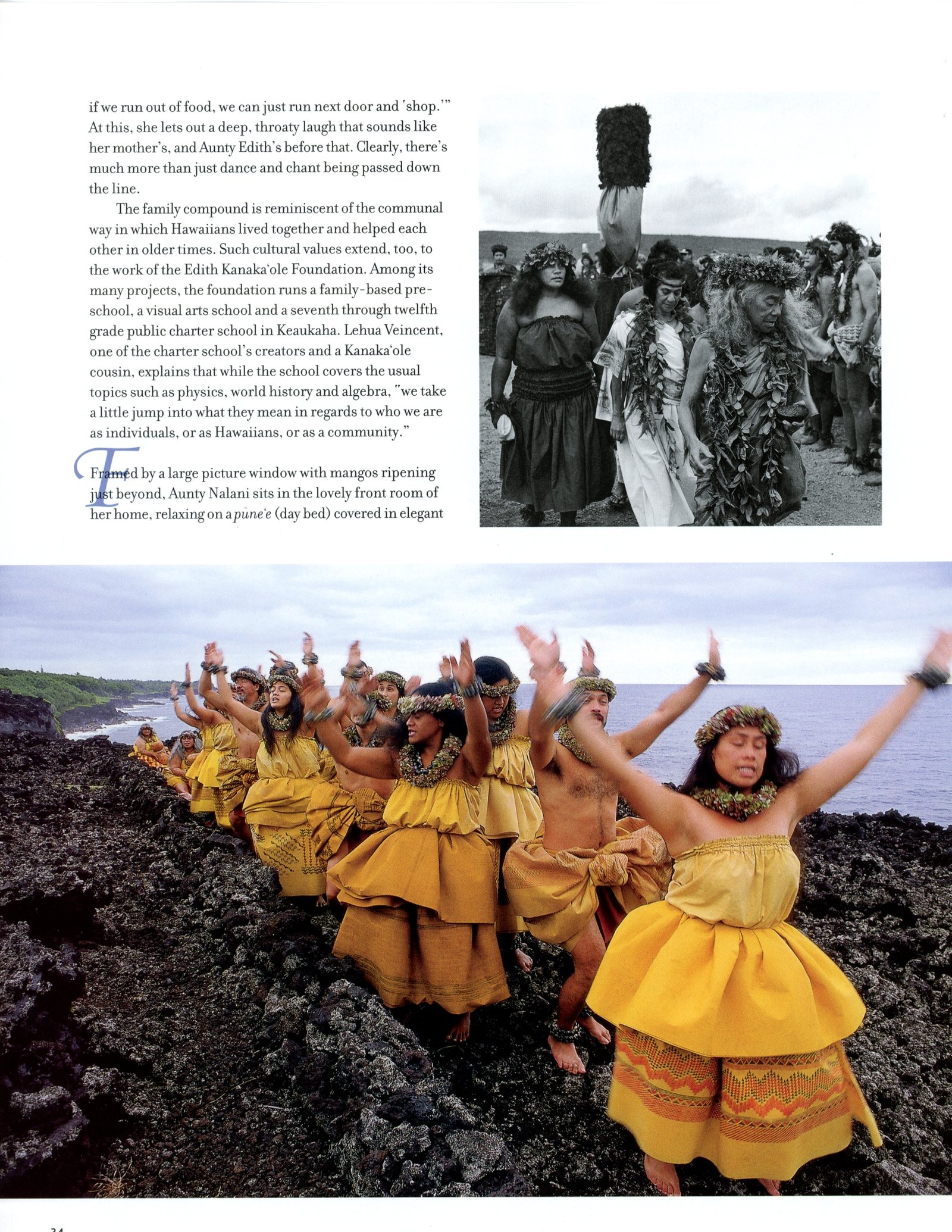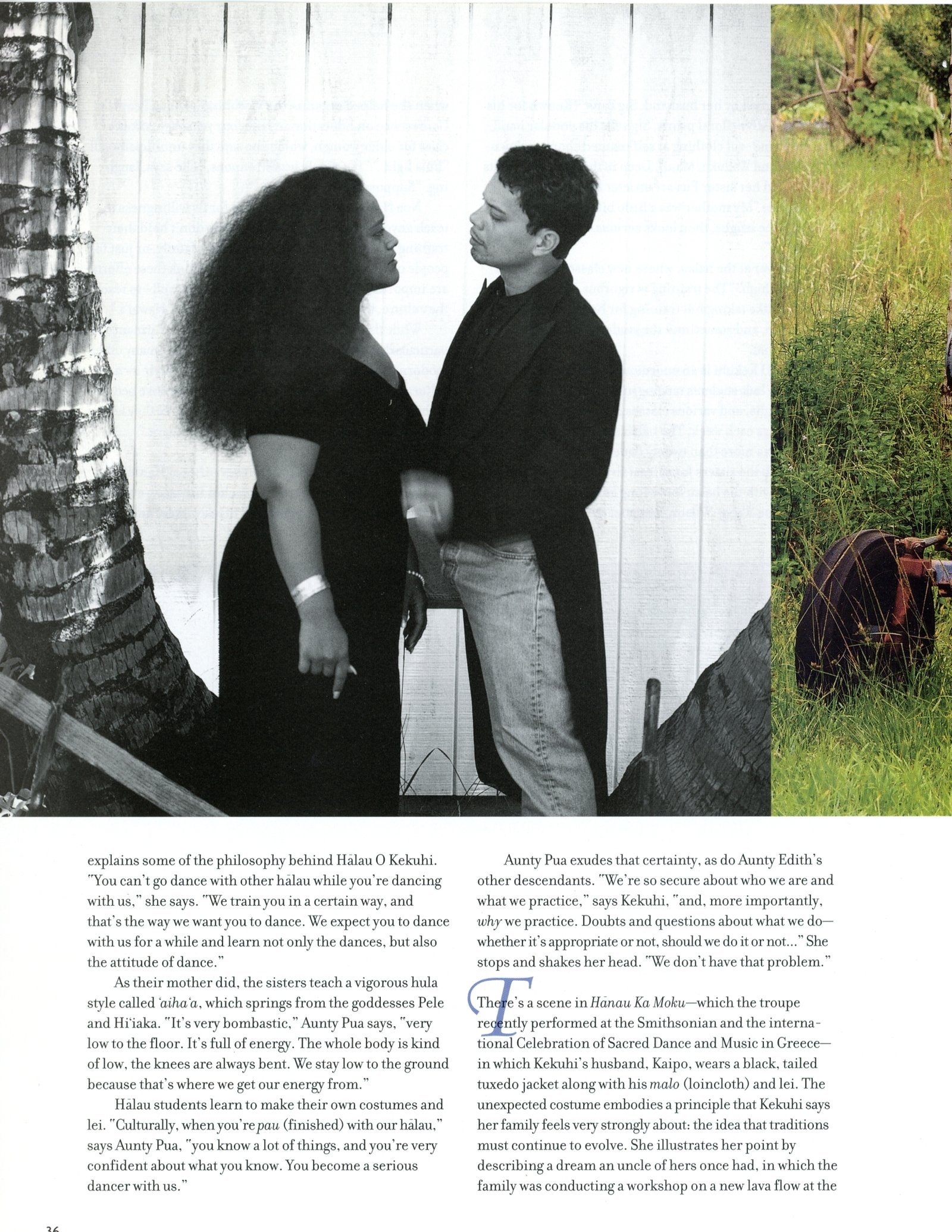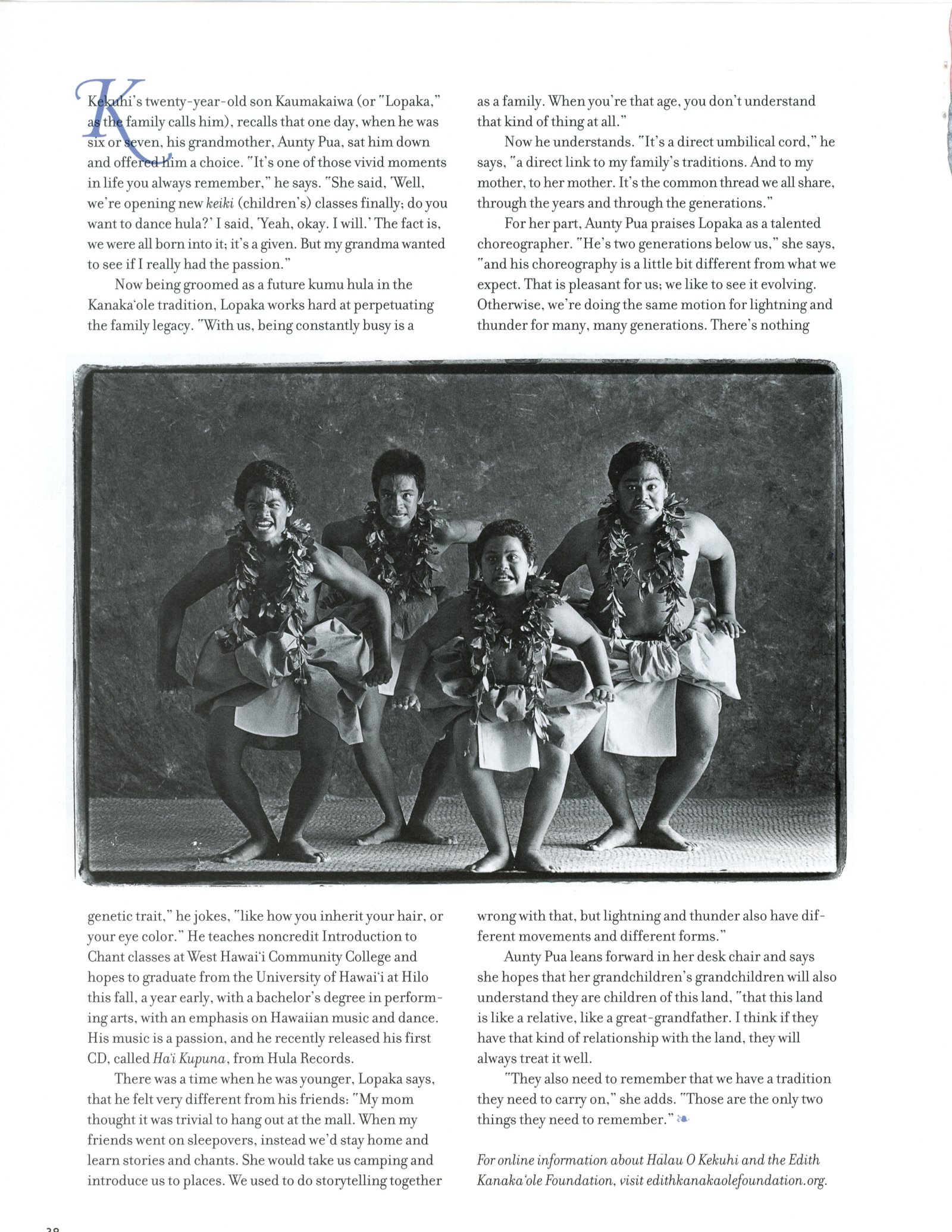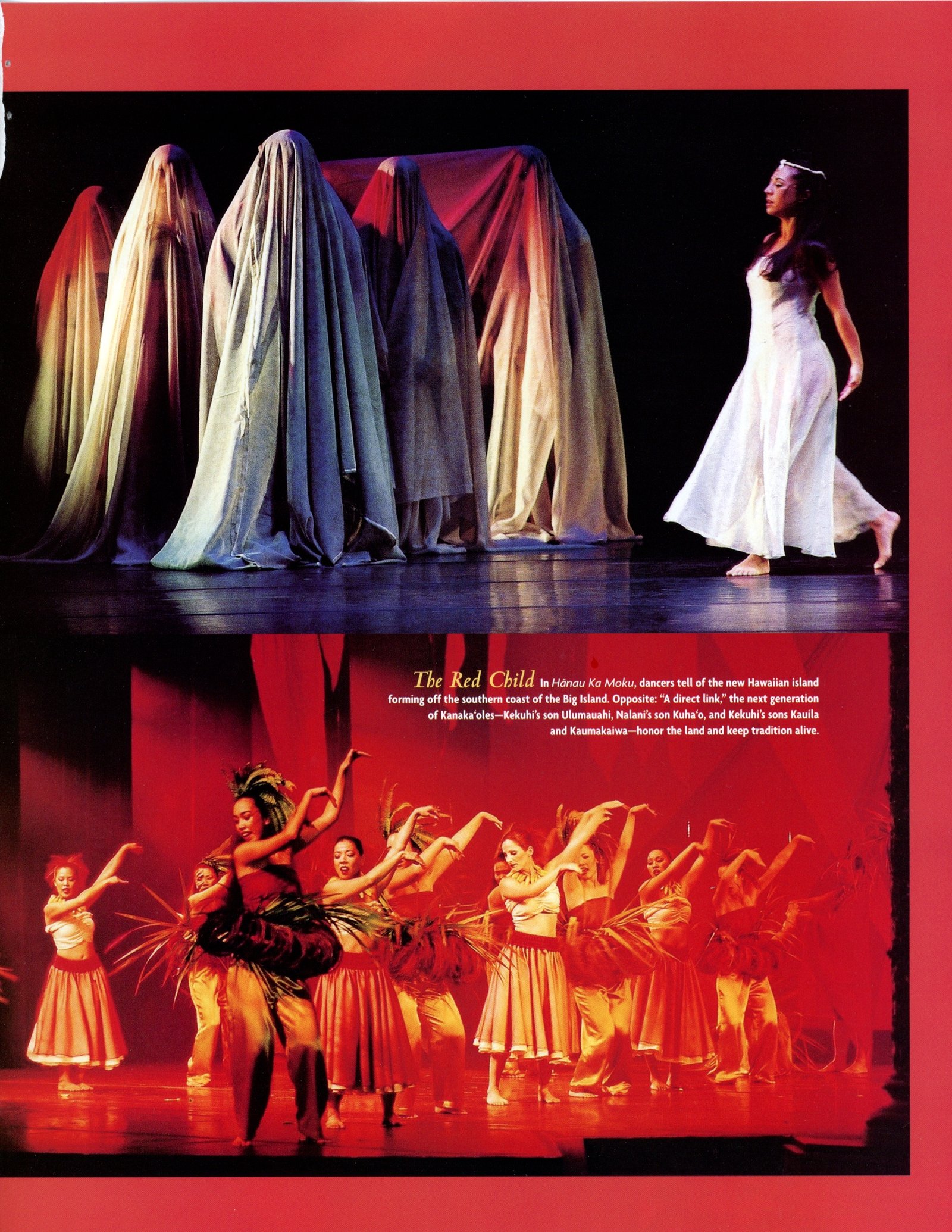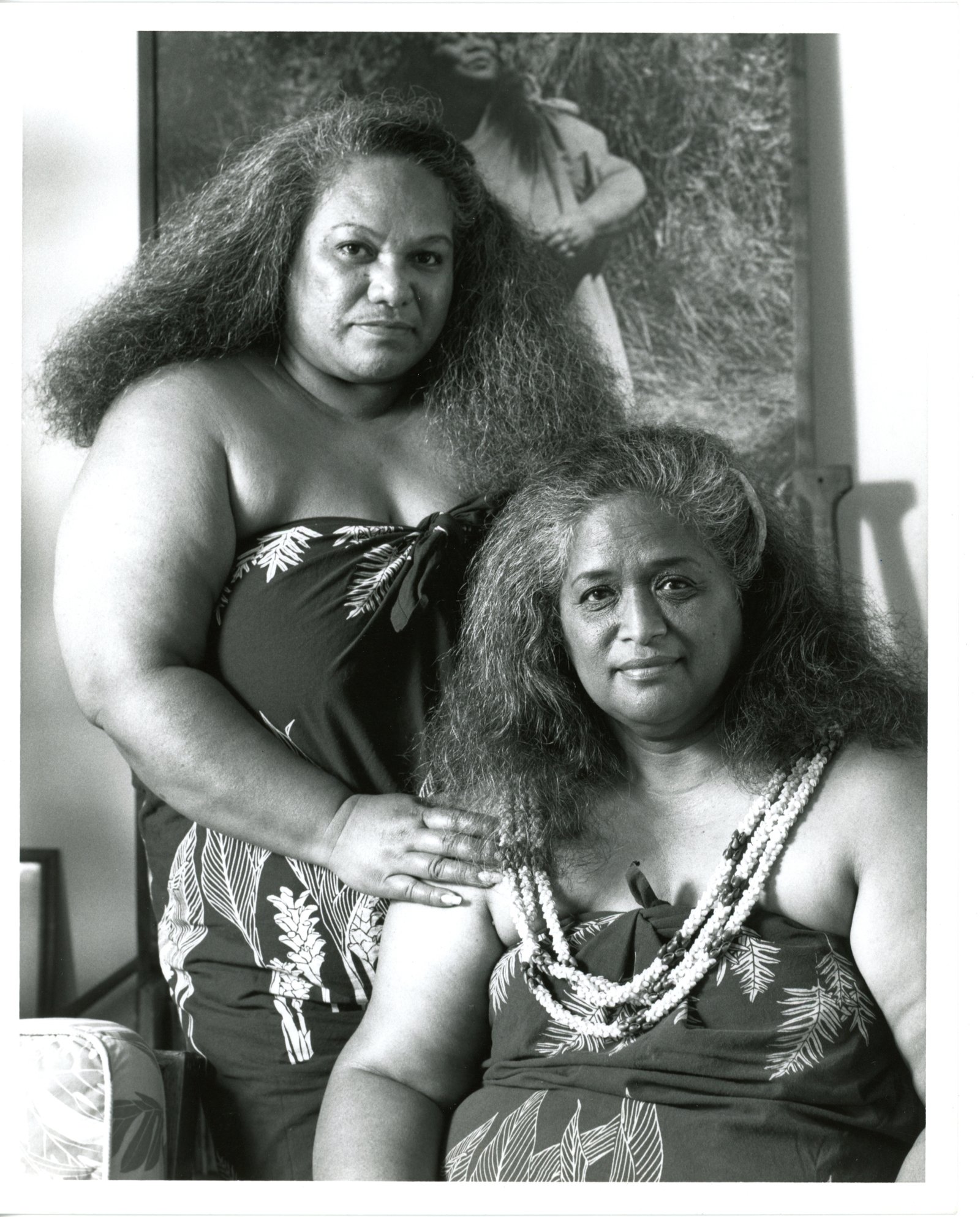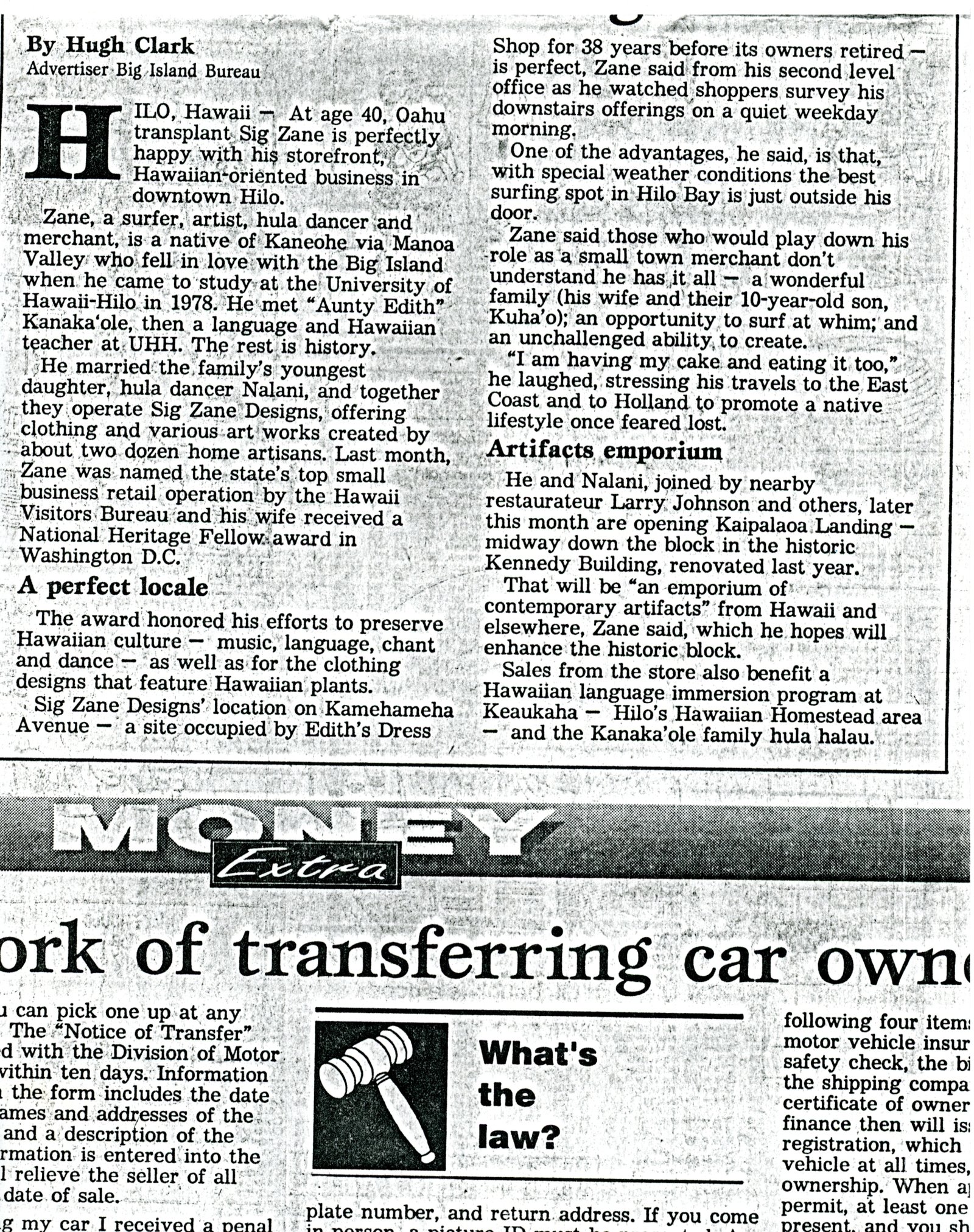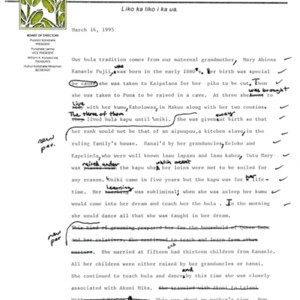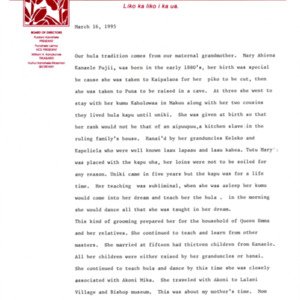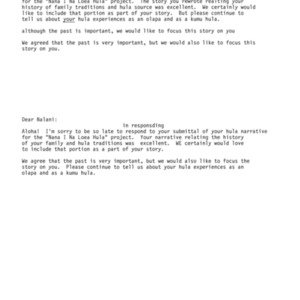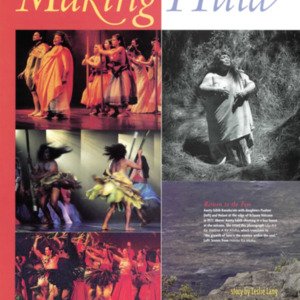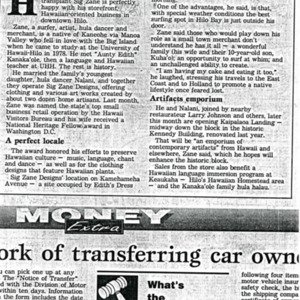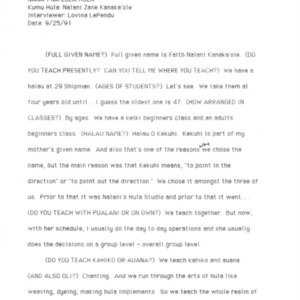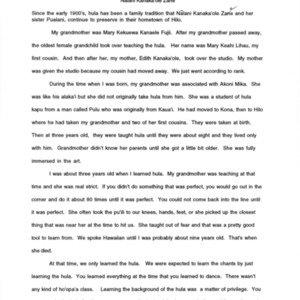Pualani Kanaka‘ole Kanahele and Nālani Kanaka‘ole
Title
Pualani Kanaka‘ole Kanahele and Nālani Kanaka‘ole
Subject
Nā Kumu Hulas Pualani Kanaka‘ole Kanahele and Nālani Kanaka‘ole - Nānā I Nā Loea Hula Volume 2 Page 54
Description
Pualani Kanaka'ole Kanahele
Daughter of renown chanter and kumu hula Edith Kanakaʻole, Pualani Kanahele along with her sister Nālani Kanaka‘ole received the National Endowment for the Arts National Heritage Fellowship Award in 1993.
I have been formally teaching hula for about twenty years. My mother and my sister Nālani taught together first. Then I taught with my mother while my sister was resting. In time my sister came back and three of us taught together until my mother died. Since then my sister and I have continued teaching hula.
I first learned hula when I was four-years-old. My teacher was my grandmother Kekuewa Kanaele who taught at her home in Keaukaha. I learned under her until I was nine- years-old then I went to my oldest cousin Mary Keahilihau. She was my grandmother’s oldest grandchild. She and my mother taught until she went to the mainland. My mother continued to teach.
My grandmother was the strictest teacher of all. She didn’t want us to play around. When it was time to dance, it was time to dance. She didn’t favor family or somebody close to her. She treated everybody alike. Everybody were students. She would praise you as well as hit you with the kumu nī‘au or the bamboo if you didn’t listen. If you were fooling around or if you didn’t observe well and you didn’t execute your steps well, you would get hit. So everytime we got hit, we would remember that motion well. That’s the way my grandmother taught.
I enjoyed dancing. I liked to get into the spirit of dancing and just dance. I also know that in my mother’s later years, she was grooming us to take over. She became more conscious of chanting and started to teach us chant styles in our later years. We already knew that we would have to take over.
Each of my three hula teachers added different things to my hula career. My grandmother taught me discipline, to pay attention, to be able to observe what was going on. Observation while you’re dancing is very important. She also taught me the basic movements. While dancing with my cousin we learned a different perspective of hula through entertainment. It allowed our hula to grow. When it came to my mother, her most valuable gift was the time she spent grooming us to be teachers. Besides chanting and the different cultural values, she shared with us what is important about dancing. Towards the end of her years she brought together what we had learned as we were growing up so we were able to understand it better. All of them added something to my life, not only to hula but to being a Hawaiian.
I think my greatest accomplishment is being able to understand the Pele and Hi‘iaka saga and putting everything in perspective. When you are dancing, you have to develop imagery. We can see a little more of that story than other people who are just listening to it. You actively become a part of the story when you do the hula.
We used to call ourselves hula ‘ōlapa. When they asked, “What are you going to dance?” We answered, “ʻōlapa.” That meant that you were going to dance with the ipu or the pahu. Hula kahiko as we know it today is done with the primary instruments and they’re usually not so literally translated. When you do the hula it is a transcendent of that spirit of that particular hula to the dancer. The dancer takes on another spirit and it is not what you do with your body hut it is what you know and what you feel inside that comes out. When the dancer has that kind of connection with her hula, then the audience will also feel it and see it.
Nālani Kanaka'ole
Nālani KanakaLole is the youngest daughter of the late hula master Edith Kanakaʻole. Nālani and her sister Pualani Kanahele are kumu hula of Hālau Kekuhi which is known for its powerful and energetic style of traditional hula.
Our hula tradition comes from our maternal grandmother Mary Ahiena Kanaele Fujii who was born in the early 1880s. Her birth was special because she was taken to Kaipalaoa for her piko to be cut. Then she was taken to Puna to be raised in a cave. At three she was brought to live with her kumu, Kaholowaa, in Maku‘u along with her two cousins. The three of them lived hula kapu until ʻūniki.
She was given away at birth so that her rank would not be that of an ‘a‘ipu‘upu‘u, a kitchen slave, in the ruling family’s house. Hānai’d by her granduncles Keleko and Kapeliela who were well known lā‘au lapa‘au and la‘au kāhea, Tūtū Mary was raised under the kapu ‘ūhū which meant her loins were not to be soiled for any reason. ‘Ūniki came in five years but the kapu was for her lifetime. Her learning was subliminal: when she was asleep her kumu would come into her dream and teach her the hula. In the morning she would dance all that she was taught in her dream.
She married at fifteen and had thirteen children from Kanaele. All her children were either raised by her granduncles or hānai. She continued to teach hula and dance and by this time she was closely associated with Akoni Mika. This was about my mother’s time.
Mom started hula at age six and there were people like Napua Stevens and the Beamer girls in her papa hula. The term given to the type of hula she was studying was hula ‘auana. They still used a kuahu and they went through kuhi pua‘a and ‘ailolo. They had a sacred pā‘ū for the ‘ailolo event but they were not tied to the kapu of the kuahu.
When it was our turn, Tūtū Fujii, as everyone liked to call her, was still teaching but the hālau was taken over by my oldest female first cousin Mary Keahilihau. Cousin took the older students and Tutu took the new students. My grandmother taught with the pūʻili in hand ready to hili the hand, feet or kīkala. Tūtū would also bring in the older women to massage our legs, arms, fingers, and step on our ‘ūhā. Soon after my cousin moved to the mainland so it was decided that my mom would take care of the hālau.
I always knew that I was going to teach. First I was the body for my mother. She would chant and I would do the motions. After a few years I did both the chanting and the teaching.
Training in our hālau is hard. The first year is strictly kahiko. The body has to be conditioned to dance forty minutes without rest. We do this for the first six months. After the first year I’ll end up with about ten students from a beginning class of sixty. In three years IʻII probably end up with about six students.
One thing I do know is that I was fortunate to have known both my grandmothers. They were both opposites but the one thing they had in common was that they both refused to speak English. We were privileged to have been raised hearing the language spoken everyday.
Daughter of renown chanter and kumu hula Edith Kanakaʻole, Pualani Kanahele along with her sister Nālani Kanaka‘ole received the National Endowment for the Arts National Heritage Fellowship Award in 1993.
I have been formally teaching hula for about twenty years. My mother and my sister Nālani taught together first. Then I taught with my mother while my sister was resting. In time my sister came back and three of us taught together until my mother died. Since then my sister and I have continued teaching hula.
I first learned hula when I was four-years-old. My teacher was my grandmother Kekuewa Kanaele who taught at her home in Keaukaha. I learned under her until I was nine- years-old then I went to my oldest cousin Mary Keahilihau. She was my grandmother’s oldest grandchild. She and my mother taught until she went to the mainland. My mother continued to teach.
My grandmother was the strictest teacher of all. She didn’t want us to play around. When it was time to dance, it was time to dance. She didn’t favor family or somebody close to her. She treated everybody alike. Everybody were students. She would praise you as well as hit you with the kumu nī‘au or the bamboo if you didn’t listen. If you were fooling around or if you didn’t observe well and you didn’t execute your steps well, you would get hit. So everytime we got hit, we would remember that motion well. That’s the way my grandmother taught.
I enjoyed dancing. I liked to get into the spirit of dancing and just dance. I also know that in my mother’s later years, she was grooming us to take over. She became more conscious of chanting and started to teach us chant styles in our later years. We already knew that we would have to take over.
Each of my three hula teachers added different things to my hula career. My grandmother taught me discipline, to pay attention, to be able to observe what was going on. Observation while you’re dancing is very important. She also taught me the basic movements. While dancing with my cousin we learned a different perspective of hula through entertainment. It allowed our hula to grow. When it came to my mother, her most valuable gift was the time she spent grooming us to be teachers. Besides chanting and the different cultural values, she shared with us what is important about dancing. Towards the end of her years she brought together what we had learned as we were growing up so we were able to understand it better. All of them added something to my life, not only to hula but to being a Hawaiian.
I think my greatest accomplishment is being able to understand the Pele and Hi‘iaka saga and putting everything in perspective. When you are dancing, you have to develop imagery. We can see a little more of that story than other people who are just listening to it. You actively become a part of the story when you do the hula.
We used to call ourselves hula ‘ōlapa. When they asked, “What are you going to dance?” We answered, “ʻōlapa.” That meant that you were going to dance with the ipu or the pahu. Hula kahiko as we know it today is done with the primary instruments and they’re usually not so literally translated. When you do the hula it is a transcendent of that spirit of that particular hula to the dancer. The dancer takes on another spirit and it is not what you do with your body hut it is what you know and what you feel inside that comes out. When the dancer has that kind of connection with her hula, then the audience will also feel it and see it.
Nālani Kanaka'ole
Nālani KanakaLole is the youngest daughter of the late hula master Edith Kanakaʻole. Nālani and her sister Pualani Kanahele are kumu hula of Hālau Kekuhi which is known for its powerful and energetic style of traditional hula.
Our hula tradition comes from our maternal grandmother Mary Ahiena Kanaele Fujii who was born in the early 1880s. Her birth was special because she was taken to Kaipalaoa for her piko to be cut. Then she was taken to Puna to be raised in a cave. At three she was brought to live with her kumu, Kaholowaa, in Maku‘u along with her two cousins. The three of them lived hula kapu until ʻūniki.
She was given away at birth so that her rank would not be that of an ‘a‘ipu‘upu‘u, a kitchen slave, in the ruling family’s house. Hānai’d by her granduncles Keleko and Kapeliela who were well known lā‘au lapa‘au and la‘au kāhea, Tūtū Mary was raised under the kapu ‘ūhū which meant her loins were not to be soiled for any reason. ‘Ūniki came in five years but the kapu was for her lifetime. Her learning was subliminal: when she was asleep her kumu would come into her dream and teach her the hula. In the morning she would dance all that she was taught in her dream.
She married at fifteen and had thirteen children from Kanaele. All her children were either raised by her granduncles or hānai. She continued to teach hula and dance and by this time she was closely associated with Akoni Mika. This was about my mother’s time.
Mom started hula at age six and there were people like Napua Stevens and the Beamer girls in her papa hula. The term given to the type of hula she was studying was hula ‘auana. They still used a kuahu and they went through kuhi pua‘a and ‘ailolo. They had a sacred pā‘ū for the ‘ailolo event but they were not tied to the kapu of the kuahu.
When it was our turn, Tūtū Fujii, as everyone liked to call her, was still teaching but the hālau was taken over by my oldest female first cousin Mary Keahilihau. Cousin took the older students and Tutu took the new students. My grandmother taught with the pūʻili in hand ready to hili the hand, feet or kīkala. Tūtū would also bring in the older women to massage our legs, arms, fingers, and step on our ‘ūhā. Soon after my cousin moved to the mainland so it was decided that my mom would take care of the hālau.
I always knew that I was going to teach. First I was the body for my mother. She would chant and I would do the motions. After a few years I did both the chanting and the teaching.
Training in our hālau is hard. The first year is strictly kahiko. The body has to be conditioned to dance forty minutes without rest. We do this for the first six months. After the first year I’ll end up with about ten students from a beginning class of sixty. In three years IʻII probably end up with about six students.
One thing I do know is that I was fortunate to have known both my grandmothers. They were both opposites but the one thing they had in common was that they both refused to speak English. We were privileged to have been raised hearing the language spoken everyday.
Citation
“Pualani Kanaka‘ole Kanahele and Nālani Kanaka‘ole,” Nā Kumu Hula Archive, accessed August 31, 2025, https://nakumuhula.org/archive/items/show/125.
